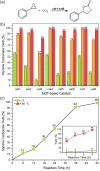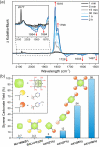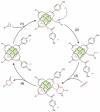Quest for an Efficient 2-in-1 MOF-Based Catalytic System for Cycloaddition of CO2 to Epoxides under Mild Conditions
- PMID: 33560110
- PMCID: PMC8023534
- DOI: 10.1021/acsami.0c20437
Quest for an Efficient 2-in-1 MOF-Based Catalytic System for Cycloaddition of CO2 to Epoxides under Mild Conditions
Abstract
We have devised a straightforward tandem postsynthetic modification strategy for Zr-based metal-organic framework (MOF) materials, which resulted in a series of well-defined 2-in-1 heterogeneous catalysts, cat1-cat8, exhibiting high catalytic activity in the synthesis of cyclic carbonates under solvent-free and co-catalyst-free conditions. The materials feature precisely located co-catalyst moieties decorating the metal nodes throughout the bulk of the MOF and yield cyclic carbonates with up to 99% efficiency at room temperature. We use diffuse reflectance infrared Fourier transform (DRIFT) and solid-state nuclear magnetic resonance (NMR) measurements to elucidate the role of each component in this model catalytic reaction. Establishing a method to precisely control the co-catalyst loading allowed us to observe the cooperativity between Lewis acid sites and the co-catalyst in the 2-in-1 heterogeneous system.
Keywords: carbon dioxide fixation; cycloaddition; heterogeneous catalysis; metal−organic framework; postsynthetic functionalization.
Conflict of interest statement
The authors declare no competing financial interest.
Figures





References
-
- Rimoldi M.; Howarth A. J.; DeStefano M. R.; Lin L.; Goswami S.; Li P.; Hupp J. T.; Farha O. K. Catalytic Zirconium/Hafnium-Based Metal–Organic Frameworks. ACS Catal. 2017, 7, 997–1014. 10.1021/acscatal.6b02923. - DOI
-
- Xu C.; Fang R.; Luque R.; Chen L.; Li Y. Functional Metal–Organic Frameworks for Catalytic Applications. Coord. Chem. Rev. 2019, 388, 268–292. 10.1016/j.ccr.2019.03.005. - DOI
LinkOut - more resources
Full Text Sources
Other Literature Sources
Miscellaneous

